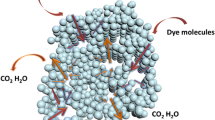Abstract
Metatitanic acid (MTA) powder was heat-treated up to 800 °C in air, and the resultant evolutions of crystalline phase, specific surface area, and pore size were investigated. MTA loses its weight in two steps; the first one (12.4 %) from 100 to 542 °C and the second one (5.2 %) from 542 to 900 °C. Both of the two stages are due to the elimination of water molecules, while the second-stage weight loss is also associated with the removal of SO4 2− ions present in MTA. As the heating temperature was elevated to 800 °C, the average pore diameter increased from 3.14 to 15.50 nm, while the specific surface area decreased from 377.3 to 54.5 m2/g. The change of these properties was most pronounced from around the temperature at which the second-stage water loss starts (542 °C). The visible-light photosensitization of rhodamine (RhB) dye on the surfaces of a partially de-hydrated MTA (heat-treated at 400 °C) was superior to that of commercial P-25 powder, indicating the potential of the partially de-hydrated mesoporous MTA with high specific surface area for the applications where surface photosensitization is important.






Similar content being viewed by others
Notes
The photosensitization is the process of initiating a reaction through the use of a light absorbing substance (e.g., dye) and transferring the energy to the desired reactants.
References
McNulty GS (2008) In: IAEA (ed) Naturally occurring radioactive material (NORM V). IAEA, Vienna
Gesenhues U (2001) Calcination of metatitanic acid to titanium dioxide white pigments. Chem Eng Technol 24:685–694
Song H, Liang B, Lü L, Wu P, Li C (2012) Effect of hydrolysis conditions on hydrous TiO2 polymorphs precipitated from a titanyl sulfate and sulfuric acid solution. Int J Miner Metall Mater 19:642–650
Jung HS, Lee J-K, Nastasi M, Lee S-W, Kim J-Y, Park J-S, Hong KS, Shin H (2005) Preparation of nanoporous MgO-coated TiO2 nanoparticles and their application to electrode of dye-sensitized solar cells. Langmuir 21:10332–10335
Hao S, Wu SJ, Huang Y, Lin J (2006) Natural dyes as photosensitizers for dye-sensitized solar cell. Sol Energy 80:209–214
Calogero G, Di Marco G, Cazzanti S, Caramori S, Argazzi R, Di Carlo A, Bignozzi CA (2010) Efficient dye-sensitized solar cells using red turnip and purple wild sicilian prickly pear fruits. Int J Mol Sci 11:254–267
Hamadanian M, Jabbari V, Gravand A (2012) Dependence of energy conversion efficiency of dye-sensitized solar cells on the annealing temperature of TiO2 nanoparticles. Mater Sci Semicond Process 15:371–379
Epling GA, Lin C (2002) Photoassisted bleaching of dyes utilizing TiO2 and visible light. Chemosphere 46:561–570
Fox MA, Whitesell JK, Magde D, Zhu LY (2009) The effect of dye density on the efficiency of photosensitization of TiO2 films: light-harvesting by phenothiazine-labelled dendritic ruthenium complexes. Molecules 14:3851–3867
Jiang D, Xu Y, Wu D, Sun Y (2008) Visible-light responsive dye-modified TiO2 photocatalyst. J Solid State Chem 181:593–602
Xu SH, Li SY, Wei YX, Zhang L, Xu F (2010) Improving the photocatalytic performance of conducting polymer polythiophene sensitized TiO2 nanoparticles under sunlight irradiation. Reac Kinet Mech Cat 101:237–249
Yasir VA, MohanDas PN, Yusuff KKM (2001) Preparation of high surface area TiO2 (anatase) by thermal hydrolysis of titanyl sulphate solution. Int J Inorg Mater 3:593–596
Tian C-X, Yang Y, Pu H (2011) Effect of calcination temperature on porous titania prepared from industrial titanyl sulfate solution. Appl Surf Sci 257:8391–8395
Gonzalez RJ (1996) Raman, infrared, X-ray, and EELS studies of nanophase titania, Ph.D. Thesis, Virginia Polytechnic Institute and State University
Knozinger H (1976) Specific poisoning and characterization of catalytically active oxide surfaces. Adv Catal 25:184–271
Rotzinger FP, Kesselman-Truttmann JM, Hug SJ, Shklover V, Grätzel M (2004) Structure and vibrational spectrum of formate and acetate adsorbed from aqueous solution onto the TiO2 rutile (110) surface. J Phys Chem B 108:5004–5017
Ge L, Xu M (2007) Fabrication and characterization of TiO2 photocatalytic thin film prepared from peroxo titanic acid sol. J Sol-Gel Sci Technol 43:1–7
Nortier P, Fourre P, Saad ABM, Saur O, Lavalley JC (1990) Effects of crystallinity and morphology on the surface properties of alumina. Appl Catal 61:141–160
Navarrete J, Lopez T, Gomez R, Figureras F (1996) Surface acidity of sulfated TiO2 − SiO2 sol-gels. Langmuir 12:4385–4390
Li X, Ye Y (2007) Photocatalytic degradation of rhodamine B over Pb3Nb4O13/fumed SiO2 composite under visible light irradiation. J Phys Chem C 111:13109–13116
Wu T, Liu G, Zhao J, Hidaka H, Serpone N (1998) Photoassisted degradation of dye pollutants. V. Self-photosensitized oxidative transformation of rhodamine B under visible light irradiation in aqueous TiO2 dispersions. J Phys Chem B 102:5845–5851
Watanabe T, Takirawa T, Honda K (1977) Photocatalysis through excitation of adsorbates. 1. Highly efficient N-deethylation of rhodamine B adsorbed to CdS. J Phys Chem 8:1845–1851
Pan L, Zou J–J, Liu X-Y, Liu X-J, Wang S, Zhang X, Wang L (2011) Visible-light-induced photodegradation of rhodamine B over hierarchical TiO2: effects of storage period and water-mediated adsorption switch. J Am Chem Soc 133:10000–10002
Merka O, Yarovyi V, Bahnemann DW, Wark M (2011) pH-control of the photocatalytic degradation mechanism of rhodamine B over Pb3Nb4O13. J Phys Chem C 115:8014–8023
Chen Y, Huang R, Chen D, Wang Y, Liu W, Li X (2012) Exploring the different photocatalytic performance for dye degradations over hexagonal ZnIn2S4 microspheres and cubic ZnIn2S4 Nanoparticles. ACS Appl Mater Interfaces 4:2273–2279
Acknowledgments
This work was financially supported by the Geo Advanced Innovative Action (GAIA) Project (No. RE201202040), funded by the Ministry of Environment of Korea through the Soil Environment Center at Korea Environmental Industry & Technology Institute (KEITI).
Author information
Authors and Affiliations
Corresponding author
Rights and permissions
About this article
Cite this article
Park, SK., Shin, H. Microstructural evolution of metatitanic acid with temperature and its photosensitization property. Reac Kinet Mech Cat 110, 237–249 (2013). https://doi.org/10.1007/s11144-013-0585-y
Received:
Accepted:
Published:
Issue Date:
DOI: https://doi.org/10.1007/s11144-013-0585-y




